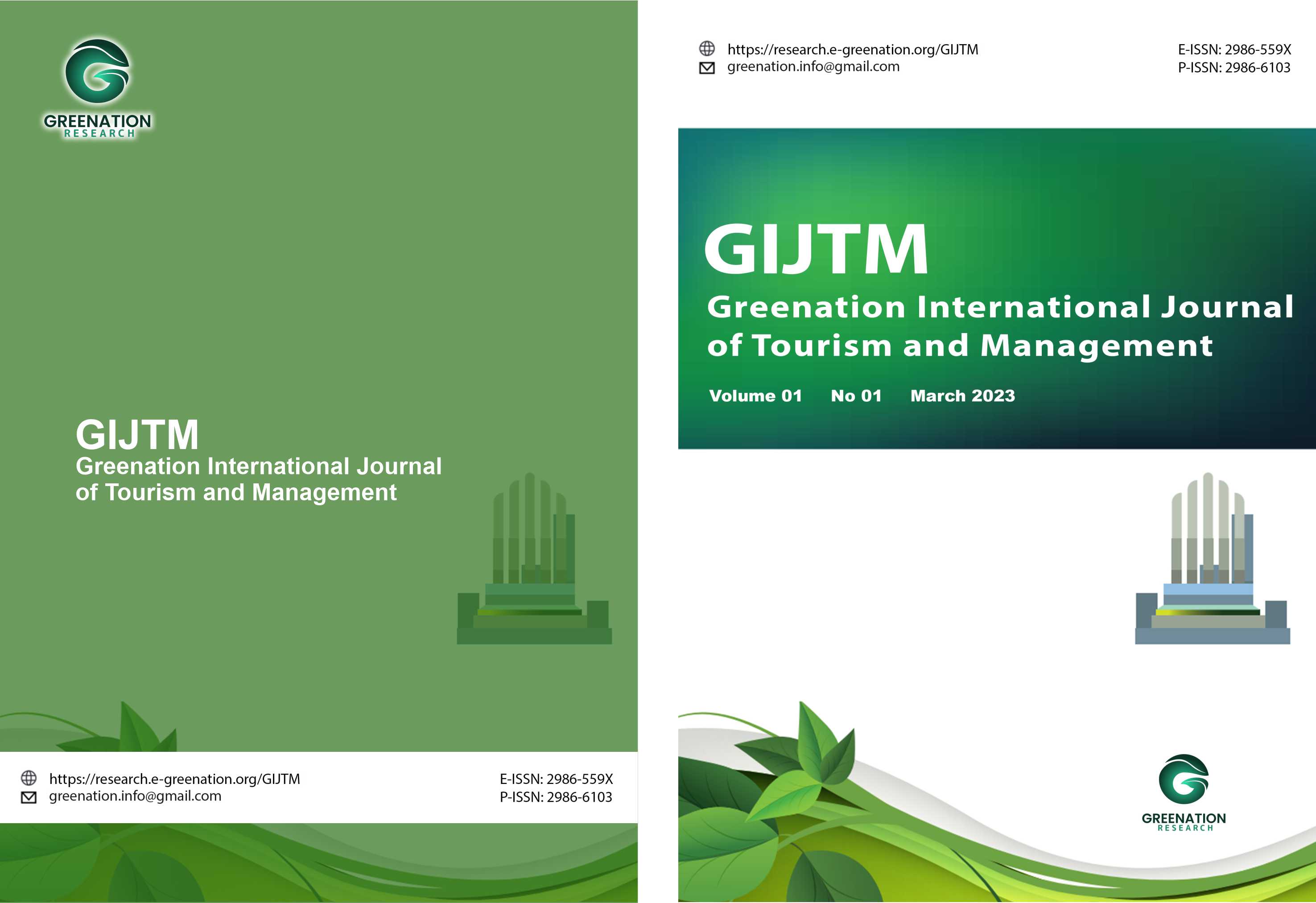The Model of Digital Communication and Supply Chains For The Tourism Industry
DOI:
https://doi.org/10.38035/gijtm.v1i3.97Keywords:
Digital Communication, Supply Chain Service, Interest In Visiting, Visiting Decisions.Abstract
This research aims to understand the effects of digital communication, supply chain services and tourism on the decision to visit Indonesia. A quantitative approach was used to gather data through 400 survey participants. This study took the form of a methodology, design and approach framework. It analyzed the effect of digital communication, supply chain services and tourism with Quantitative data collected from Indonesia tourists and social media users. Probability sampling was used to collect data in a random manner. This method was used in a study that used Structural Equation Modeling and the SEM-PLS method. Results showed that digital supply chain and communication services had a significant positive impact on the interest of visitors. This led to a significant increase in their choice to visit a location. Additionally, this led to a significant increase in the impact of their decision on whether or not to visit.
References
Bellezza, S., & Keinan, A. (2014). Brand Tourists: How Non–Core Users Enhance the Brand Image by Eliciting Pride. Journal of Consumer Research, 41(2), 397–417. https://doi.org/10.1086/676679
Cavusoglu, M. (2019). An analysis of technology applications in the restaurant industry. Journal of Hospitality and Tourism Technology. https://doi.org/10.1108/JHTT-12-2017-0141
Chen, C. F., & Phou, S. (2013). A closer look at destination: Image, personality, relationship and loyalty. Tourism Management. https://doi.org/10.1016/j.tourman.2012.11.015
Chmielarz, W. (2015). Information technology project management. Information technology project management. https://doi.org/10.7172/978-83-65402-07-3.2015.wwz.4
Delgado-Ballester, E., Navarro, A., & Sicilia, M. (2012). Revitalising brands through communication messages: The role of brand familiarity. European Journal of Marketing. https://doi.org/10.1108/03090561211189220
Dirhamsyah. (2007). An Economic Valuation of Seagrass Ecosystem in East Bintan, Riau Archipelago, Indonesia. Oseanologi Dan Limnologi Indonesia2.
Ellen MacArthur Foundation and McKinsey Center for Business and Environment. (2015). Growth within: a circular economy vision for a competitive europe. Ellen MacArthur Foundation.
Fay, S., & Haydon, L. (2017). The location of culture. The Location of Culture. https://doi.org/10.4324/9781912281701
Felix, R., Rauschnabel, P. A., & Hinsch, C. (2017). Elements of strategic social media marketing: A holistic framework. Journal of Business Research. https://doi.org/10.1016/j.jbusres.2016.05.001
Frías Jamilena, D. M., Polo Peña, A. I., & Rodríguez Molina, M. Á. (2017). The Effect of Value-Creation on Consumer-Based Destination Brand Equity. Journal of Travel Research. https://doi.org/10.1177/0047287516663650
Gasalla, M. A., Rodrigues, A. R., Duarte, L. F. A., & Rashid Sumaila, U. (2010). A comparative multi-fleet analysis of socio-economic indicators for fishery management in SE Brazil. Progress in Oceanography. https://doi.org/10.1016/j.pocean.2010.09.011
Grønhaug, K., Kleppe, I. A., & Haukedal, W. (1987). Observation of a strategic household purchase decision. Psychology & Marketing. https://doi.org/10.1002/mar.4220040307
Hall, J., Matos, S., Sheehan, L., & Silvestre, B. (2012). Entrepreneurship and innovation at the base of the Pyramid: A recipe for inclusive growth or social exclusion? Journal of Management Studies. https://doi.org/10.1111/j.1467-6486.2012.01044.x
Hjort, K., Lantz, B., Ericsson, D., & Gattorna, J. (2013). Customer segmentation based on buying and returning behaviour. International Journal of Physical Distribution & Logistics Management, 43(10), 852–865. https://doi.org/10.1108/IJPDLM-02-2013-0020
IASB. (2016). IAS 19 Employee Benefits. In IFRS Green Book 2016 Part A (pp. A1027–A1084). https://doi.org/10.1007/978-3-8349-6633-9
Kassim, N., & Asiah Abdullah, nor. (2010). The effect of perceived service quality dimensions on customer satisfaction, trust, and loyalty in e-commerce settings: A cross cultural analysis. Asia Pacific Journal of Marketing and Logistics. https://doi.org/10.1108/13555851011062269
Kraak, V. I., Harrigan, P. B., Lawrence, M., Harrison, P. J., Jackson, M. A., & Swinburn, B. (2012). Balancing the benefits and risks of public-private partnerships to address the global double burden of malnutrition. Public Health Nutrition. https://doi.org/10.1017/S1368980011002060
Lemmetyinen, A., Dimitrovski, D., Nieminen, L., & Pohjola, T. (2016). Cruise destination brand awareness as a moderator in motivation-satisfaction relation. Tourism Review. https://doi.org/10.1108/TR-07-2016-0027
Li, X. R., & Kaplanidou, K. K. (2013). The Impact of the 2008 Beijing Olympic Games on China’s Destination Brand: A U.S.-Based Examination. Journal of Hospitality and Tourism Research. https://doi.org/10.1177/1096348011425499
Limakrisna, N., & Ali, H. (2016). Model of Customer Satisfaction: Empirical Study At Fast Food Restaurants in Bandung. International Journal of Business and Commerce.
Mattingly, T. J., Mullins, D., Melendez, D. R., Boyden, K., & Eddington, N. D. (2019). A systematic review of entrepreneurship in pharmacy practice and education. American Journal of Pharmaceutical Education. https://doi.org/10.5688/ajpe7233
Matzler, K., Strobl, A., Stokburger-Sauer, N., Bobovnicky, A., & Bauer, F. (2016). Brand personality and culture: The role of cultural differences on the impact of brand personality perceptions on tourists’ visit intentions. Tourism Management. https://doi.org/10.1016/j.tourman.2015.07.017
Mudege, N. N., Kapalasa, E., Chevo, T., Nyekanyeka, T., & Demo, P. (2015). Gender norms and the marketing of seeds and ware potatoes in Malawi. Journal of Gender, Agriculture and Food Security.
Muriithi, J. G., Wanjau, K., & Omondi, H. (2018). Performance of Incubator Centres in Kenya. International Journal of Research in Business and Social Science (2147-4478). https://doi.org/10.20525/ijrbs.v7i1.859
Oliveira, E., & Panyik, E. (2015). Content, context and co-creation: Digital challenges in destination branding with references to Portugal as a tourist destination. Journal of Vacation Marketing. https://doi.org/10.1177/1356766714544235
Oliveira, T., Thomas, M., Baptista, G., & Campos, F. (2016). Mobile payment: Understanding the determinants of customer adoption and intention to recommend the technology. Computers in Human Behavior, 61(2016), 404–414. https://doi.org/10.1016/j.chb.2016.03.030
Priatna, D. K., Limakrisna, N., & Roswinna, W. (2017). Model of consumer behavior intention. International Journal of Economic Research.
Robbins, S. P., & Judge, T. A. (2013). Organizational Behavior 15th Edition. The Curated Reference Collection in Neuroscience and Biobehavioral Psychology.
Sayuti, S. D., & Aras, M. (2016). Effect of the 2014 election campaign material in increasing beginner voters’ knowledge among students. Pertanika Journal of Social Sciences and Humanities.
Sichtmann, C., & Diamantopoulos, A. (2013). The impact of perceived brand globalness, brand origin image, and brand origin-extension fit on brand extension success. Journal of the Academy of Marketing Science, 41(5), 567–585. https://doi.org/10.1007/s11747-013-0328-7
Su, J., & Tong, X. (2015). Brand personality and brand equity: Evidence from the sportswear industry. Journal of Product and Brand Management. https://doi.org/10.1108/JPBM-01-2014-0482
Teo, C., Chui, B., Rahim, F. A., Hassan, F. H., Musa, R., & Yusof, J. (2010). Exploring Tourist Experiencescape and Servicescape at Taman Negara ( National Park. International Journal. https://doi.org/http://dx.doi.org/10.7763/IJTEF.2010.V1.5
Tiago, M. T. P. M. B., & Veríssimo, J. M. C. (2014). Digital marketing and social media: Why bother? Business Horizons. https://doi.org/10.1016/j.bushor.2014.07.002
York, J. L., & Danes, J. E. (2014). Customer development, innovation, and decision-making biases in the Lean Startup. Journal Os Small Business Strategy. https://doi.org/10.1111/j.1748-5827.2011.01219.x
Downloads
Published
How to Cite
Issue
Section
License
Copyright :
Authors who publish their manuscripts in this journal agree to the following conditions:
- Copyright in each article belongs to the author.
- The author acknowledges that the Greenation International Journal of Tourism and Management (GIJTM) has the right to be the first to publish under a Creative Commons Attribution 4.0 International license (Attribution 4.0 International CC BY 4.0).
- Authors can submit articles separately, arrange the non-exclusive distribution of manuscripts that have been published in this journal to other versions (for example, sent to the author's institutional repository, publication in a book, etc.), by acknowledging that the manuscript has been published for the first time at GIJTM.


























